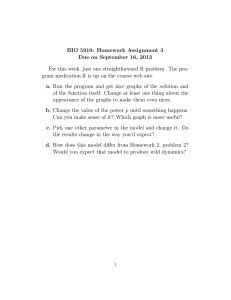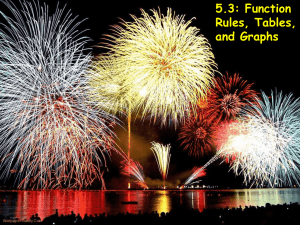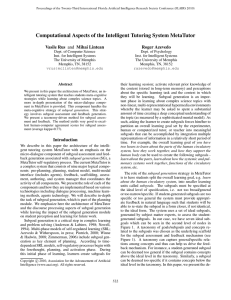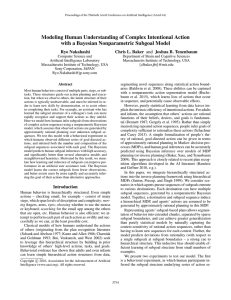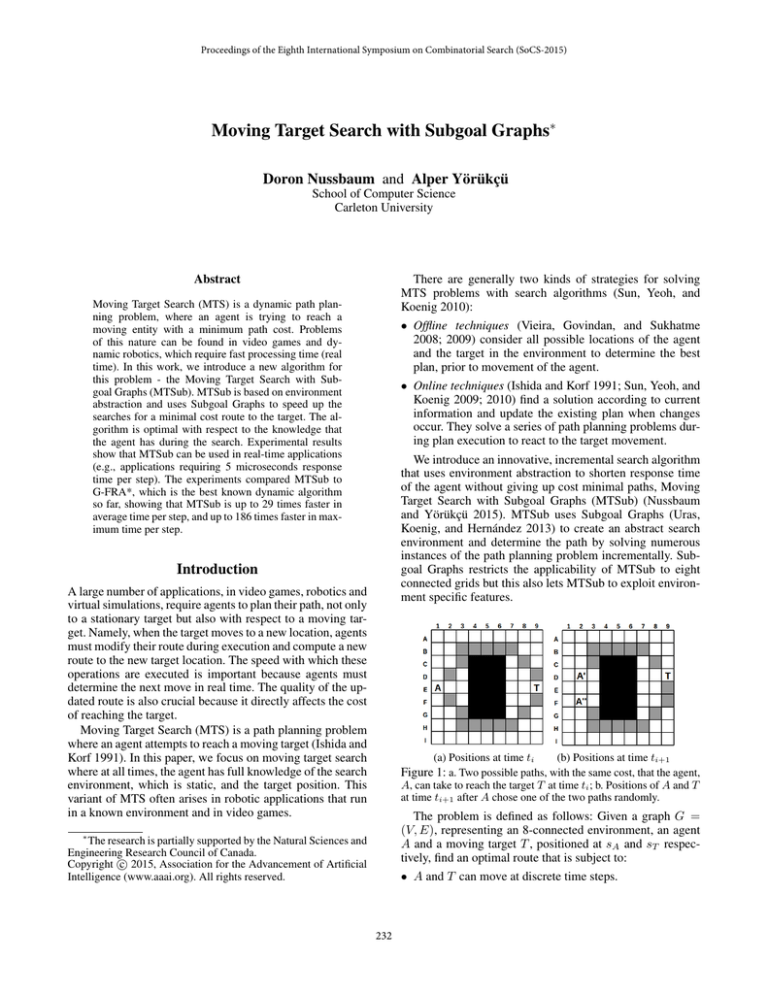
Proceedings of the Eighth International Symposium on Combinatorial Search (SoCS-2015)
Moving Target Search with Subgoal Graphs∗
Doron Nussbaum and Alper Yörükçü
School of Computer Science
Carleton University
Abstract
There are generally two kinds of strategies for solving
MTS problems with search algorithms (Sun, Yeoh, and
Koenig 2010):
Moving Target Search (MTS) is a dynamic path planning problem, where an agent is trying to reach a
moving entity with a minimum path cost. Problems
of this nature can be found in video games and dynamic robotics, which require fast processing time (real
time). In this work, we introduce a new algorithm for
this problem - the Moving Target Search with Subgoal Graphs (MTSub). MTSub is based on environment
abstraction and uses Subgoal Graphs to speed up the
searches for a minimal cost route to the target. The algorithm is optimal with respect to the knowledge that
the agent has during the search. Experimental results
show that MTSub can be used in real-time applications
(e.g., applications requiring 5 microseconds response
time per step). The experiments compared MTSub to
G-FRA*, which is the best known dynamic algorithm
so far, showing that MTSub is up to 29 times faster in
average time per step, and up to 186 times faster in maximum time per step.
• Offline techniques (Vieira, Govindan, and Sukhatme
2008; 2009) consider all possible locations of the agent
and the target in the environment to determine the best
plan, prior to movement of the agent.
• Online techniques (Ishida and Korf 1991; Sun, Yeoh, and
Koenig 2009; 2010) find a solution according to current
information and update the existing plan when changes
occur. They solve a series of path planning problems during plan execution to react to the target movement.
We introduce an innovative, incremental search algorithm
that uses environment abstraction to shorten response time
of the agent without giving up cost minimal paths, Moving
Target Search with Subgoal Graphs (MTSub) (Nussbaum
and Yörükçü 2015). MTSub uses Subgoal Graphs (Uras,
Koenig, and Hernández 2013) to create an abstract search
environment and determine the path by solving numerous
instances of the path planning problem incrementally. Subgoal Graphs restricts the applicability of MTSub to eight
connected grids but this also lets MTSub to exploit environment specific features.
Introduction
A large number of applications, in video games, robotics and
virtual simulations, require agents to plan their path, not only
to a stationary target but also with respect to a moving target. Namely, when the target moves to a new location, agents
must modify their route during execution and compute a new
route to the new target location. The speed with which these
operations are executed is important because agents must
determine the next move in real time. The quality of the updated route is also crucial because it directly affects the cost
of reaching the target.
Moving Target Search (MTS) is a path planning problem
where an agent attempts to reach a moving target (Ishida and
Korf 1991). In this paper, we focus on moving target search
where at all times, the agent has full knowledge of the search
environment, which is static, and the target position. This
variant of MTS often arises in robotic applications that run
in a known environment and in video games.
(a) Positions at time ti
(b) Positions at time ti+1
Figure 1: a. Two possible paths, with the same cost, that the agent,
A, can take to reach the target T at time ti ; b. Positions of A and T
at time ti+1 after A chose one of the two paths randomly.
The problem is defined as follows: Given a graph G =
(V, E), representing an 8-connected environment, an agent
A and a moving target T , positioned at sA and sT respectively, find an optimal route that is subject to:
∗
The research is partially supported by the Natural Sciences and
Engineering Research Council of Canada.
c 2015, Association for the Advancement of Artificial
Copyright Intelligence (www.aaai.org). All rights reserved.
• A and T can move at discrete time steps.
232
• At each time step ti , T positioned at u = position(T, ti )
can either stay put or move to node v where v ∈
neighbour(u).
Constructed
Random
• At each time step ti , A, positioned at (p =
position(A, ti )), can detect the position of T (u =
position(T, ti )), compute a path Π(p, u) and move to a
node w where w ∈neighbour(u)∧w ∈Π(p, u).
Room
Maze
An optimal route is a route from position(A, to ) to
position(T, tk ), when to is the time that A and T attempted
to move, tk is the time that A reached T , and ∀ti to ≤ti ≤tk ,
position(A, ti)∈ Π(position(A, ti−1 ),position(T, ti−1 ))
where Π is a cost minimal path.
Note that following an optimal route may not minimize
the cost of reaching the target. Figure 1 depicts a search environment at time ti and ti+1 where black cells represent
obstacles, ‘A’ and ‘T’ show sA and sT , respectively. Two obstacle free paths are displayed in Figure 1a. The paths have
the same cost. However, Figure 1b shows that the agent’s
random choice of paths at time ti may not be the best choice
to get closer to the target. Experiments show that following
an optimal route decreases the cost of reaching the target in
most cases (Sun et al. 2012).
Avg.
Max
Avg
Max
Avg.
Max
Avg.
Max
R-A*
325.20
9369
284.2
5389
626.48
9858
8571.96
38315
R-Sub
12.09
188
270.10
6588
23.09
810
852.71
7871
GFRA*
140.54
26857
91.66
15533
163.25
33507
648.5
80054
MTSub
6.85
144
50.56
5140
5.66
304
44.85
4523
Table 1: Experiments in 512 x 512 Maps, Times are Given in µ
seconds. All reported times are per step where Avg. is the average
time per step and Max is the maximum time per step. Note the
effect of map type on the performance of the algorithms.
comparison to G-FRA*, MTSub is up to 29 times faster in
average time per step, and up to 186 times faster in maximum time per step. The results shows MTSub advantage of
using environment abstraction and incremental search.
Conclusions
In this paper, we introduced an innovative incremental
search algorithm that uses environment abstraction to speed
up the response time of an agent that searches for a moving
target. Empirical evaluation shows that MTSub outperforms
G-FRA*, R-Sub and R-A* in all of the experiment domains.
MTSub average performance meets real time requirements
and is applicable to video games and robotics that use not
only small environments but also larger ones with lower resources.
Moving Target Search with Subgoal Graphs
Moving Target Search with Subgoal Graphs(MTSub) is an
optimal algorithm that attempts to update the path based
on knowledge from the previous step. MTSub is different
from the other incremental MTS algorithms because it uses
a Subgoal Graph (SG) (Uras, Koenig, and Hernández 2013),
which is constructed during a preprocessing step.
MTSub used SG to create environment abstraction, thus,
reducing the size of the search space of the eight connected
grid environment. Instead of searching, at every time step,
for a cost minimal path in the given eight connected graph,
MTSsub searches the SG. MTSub achieves its speed up by
incremental search of the environment using the SG and by
reducing the number of times that a complete shortestp path
tree is computed.
We compared MTSub against several MTS algorithms: GFRA*, which is an incremental algorithm, and A* and TwoLevel Subgoal Graphs which are shortest path planning algorithms. The latter two algorithms are invoked repetitively
to solve MTS and are referred to as Repeating A* (R-A*)
and Repeating Two-Level Subgoal Graphs (R-Sub).
The experiments were conducted as follows: First, a predefined set of maps were selected. The size of a graph and
obstacles size and location were determined by each map.
Second, 100 scenarios were created including target and
agent initial location, and the target’s random motion (each
algorithm was tested using the same 100 scenarios). Four
classes of maps were used to examine the impact of different
environment on the algorithms performance: constructed,
maze, random and room maps. We conducted the experiments in maps scaled 512 x 512 with 100 scenarios per map.
For each map class, we chose 6 different maps.
The results of the experiments are depicted in Table 1. In
these experiments MTSub outperforms all of the competing
algorithms in both average and maximum time per step. In
References
Ishida, T., and Korf, R. E. 1991. Moving target search. In IJCAI,
volume 91, 204–210.
Nussbaum, D., and Yörükçü, A. 2015. Moving target search with
subgoal graphs. In Twenty-Fifth International Conference on Automated Planning and Scheduling. Forthcoming.
Sun, X.; Yeoh, W.; Uras, T.; and Koenig, S. 2012. Incremental
ara*: An incremental anytime search algorithm for moving-target
search. In Twenty-Second International Conference on Automated
Planning and Scheduling, 243–232.
Sun, X.; Yeoh, W.; and Koenig, S. 2009. Efficient incremental
search for moving target search. In Twenty-First International Joint
Conference on Artificial Intelligence, 615–620.
Sun, X.; Yeoh, W.; and Koenig, S. 2010. Moving target d* lite. In
Proceedings of the 9th International Conference on Autonomous
Agents and Multiagent Systems: volume 1-Volume 1, 67–74. International Foundation for Autonomous Agents and Multiagent Systems.
Uras, T.; Koenig, S.; and Hernández, C. 2013. Subgoal graphs
for optimal pathfinding in eight-neighbor grids. In Twenty-Third
International Conference on Automated Planning and Scheduling,
224–232.
Vieira, M. A.; Govindan, R.; and Sukhatme, G. S. 2008. Optimal
policy in discrete pursuit-evasion games. Department of Computer
Science, University of Southern California, Tech. Rep 08–900.
Vieira, M. A.; Govindan, R.; and Sukhatme, G. S. 2009. Scalable
and practical pursuit-evasion with networked robots. Intelligent
Service Robotics 2(4):247–263.
233



